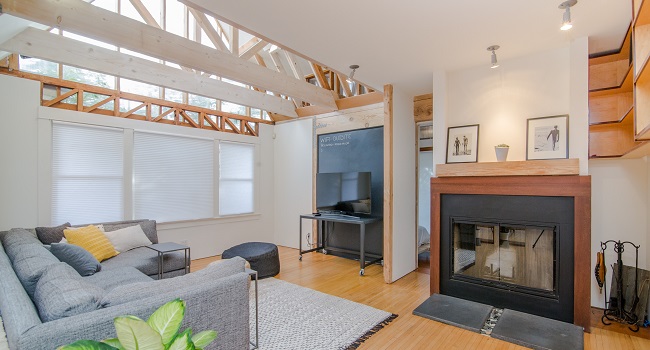Home > industry news > Greening Life and Home: Your Helpful Guide to Sustainable Living Essentials
The modern home has evolved beyond being a place of rest and relaxation. In a post-pandemic world, many are doing their jobs remotely. A lot of people have transitioned from an office cubicle to a work desk in the spare bedroom.

Did you make the switch to work-from-home too? If so, you’ll know that, as convenient as it is, there are also downsides to the setup. Increased utility bills and a decrease in physical activity are the two most obvious cons.
Creating an environmentally friendly haven and following sustainable living practices can help. So jump right in and learn how you can green your life and home in this article.
Energy-Efficient Home Design
When it comes to sustainable living essentials, energy-efficient home design takes center stage. The following are three key elements to make your home greener and more economical.
Passive Solar Design
Harnessing the power of the sun, passive solar design ensures that your home maximizes natural light and heat. South-facing windows allow sunlight to flood in during winter, reducing the need for artificial heating. In summer, strategic shading keeps your space cool. It’s an eco-friendly win-win.
Insulation and Weatherization
Proper insulation and weatherization form the backbone of energy efficiency. Insulating your walls, roof, and floors keeps your home cozy while cutting heating and cooling costs. Meanwhile, sealing gaps and cracks will prevent energy leaks, making internal temperature control more effective.
Efficient Windows and Doors
Replacing old, drafty windows and doors with energy-efficient ones can significantly impact your home’s energy consumption. Double-paned windows and well-sealed doors keep the elements at bay and maintain a comfortable indoor climate year-round.
Incorporating these energy-efficient design principles into your home not only reduces your carbon footprint but also saves you money on energy bills.
Sustainable Building Materials
Choosing the right building materials is vital to constructing an abode with low energy utilization.
With that, consider these sustainable options for your next build:
Bamboo
Bamboo is a remarkable choice due to its rapid growth and renewability. It’s sturdy, versatile, and can replace traditional hardwoods. This alternative to wood timber also absorbs more carbon dioxide and releases more oxygen than many trees, making it an excellent environmental choice.
Recycled Steel
Using recycled steel reduces the need for mining and energy-intensive production. It’s durable, long-lasting, and can be used for structural elements, roofing, and more. Choosing this building material decreases waste and lessens the carbon footprint of your home.
Straw Bales
Straw bales are natural insulators and offer excellent thermal performance. They’re often used in eco-friendly construction, especially for walls. Straw is an agricultural byproduct, making it a renewable and low-impact choice.
These sustainable building materials not only contribute to a greener planet but also provide energy-efficient and durable solutions for your home. Incorporating them into your construction project is a step towards sustainable living and reducing your environmental impact.
Minimalist and Functional Interior Design
Embracing this approach can transform your living space into a peaceful, clutter-free haven. Here’s how to curate this ambiance while reducing waste and promoting sustainability:
Reducing Clutter
Minimalism is about simplifying. It means decluttering your living spaces, keeping what you truly need, and letting go of excess. Doing so creates an environment that’s visually soothing while practicing mindful consumption.
Multi-Functional Furniture
Maximize your space with multi-functional furniture. These ingenious pieces, like sofa beds and storage ottomans, are the epitome of functionality. They save space while enhancing your living experience.
Eco-Friendly Flooring Options
Your choice of flooring can significantly impact sustainability. Opt for eco-friendly materials like bamboo, reclaimed wood, or cork. Not only are they durable, but they’re stylish and sustainable too!

Harnessing Renewable Energy Sources
The use of a renewable energy source complements an energy-efficient home design. These eco-friendly options can reduce your carbon footprint and bring long-term savings. Let’s explore the top choices:
Solar Panels
Mounted on your roof or in your backyard, solar panels quietly soak up the sun’s energy, powering your home. Besides reducing your electricity bills, using solar power in homes is a clean, low-maintenance energy source. It’s an investment in both your wallet and the planet.
Wind Turbines
Wind turbines aren’t just a picturesque addition to the landscape. They’re powerhouses of green energy. As the wind spins their blades, they generate electricity. Whether you live in a windy locale or just get occasional breezes, harnessing the wind’s energy can be a smart move. You can store surplus power or even sell it back to the grid.
Geothermal Heating and Cooling
Geothermal systems are the unsung heroes of energy-efficient living. By tapping into the Earth’s consistent temperature, they keep your home comfortable year-round with minimal energy use. These systems are eco-friendly and can significantly lower your heating and cooling costs over time.
Incorporating these renewable energy sources into your lifestyle isn’t just a trend—it’s a commitment to a sustainable future. Plus, it’s a win-win, reducing your bills while helping to protect our planet.
Water Conservation Essentials for Sustainable Living
When it comes to sustainable living, water conservation is a fundamental aspect to consider in your home. By making a few simple changes, you can contribute to both a greener planet and lower utility bills. Here are five essential strategies:
Sustainable Lifestyle Habits
It’s not enough to build an energy-efficient home and decorate it with multipurpose furniture. You should also be willing to adopt a more eco-conscious way of life. The following practical tips not only benefit the planet but also contribute to healthier living.
Energy Conservation
Waste Reduction
Benefits of Sustainable Living
Sustainable living is a path to a brighter future for our planet and ourselves. Let’s explore the remarkable benefits it brings.
Environmental Benefits
Reduction in carbon footprint: Embracing sustainable practices like reducing waste and conserving energy lowers our carbon footprint. As we cut down on harmful emissions, we contribute to a cleaner, healthier atmosphere for all.

Biodiversity conservation: Making eco-friendly choices in our daily lives allows us to protect natural habitats and biodiversity. Imagine bees living in boxes. venturing out to pollinate flowers in a garden. Preserving these ecosystems ensures a thriving planet with diverse species and a more balanced environment.
Health and Well-Being
Improved air and water quality: Sustainable living promotes cleaner air and water. This means breathing fresher air and drinking purer water, leading to better health for you and your loved ones.
Physical and mental health benefits: Connecting with nature, engaging in active transportation, and eating locally sourced, organic foods can boost both physical and mental well-being. This reduces stress and improves mood.
Financial Savings
Energy and utility bill savings: Sustainable choices at home, like efficient appliances and renewable energy sources, translate to lower utility bills. You are saving money while helping the planet—what’s not to love?
Reduced healthcare costs: A healthier lifestyle often leads to fewer medical bills. When you limit your exposure to pollutants and embrace a sustainable diet, you invest in long-term health and savings.
Social Impact
Fostering sustainable communities: Sustainable living fosters close-knit communities focused on shared values. Working together to reduce waste and conserve resources creates stronger bonds among neighbors.
Encouraging sustainable practices globally: Your actions inspire others. By living sustainably, you encourage a global shift towards eco-conscious choices, setting an example for a brighter, greener future.
Conclusion
Energy-efficient design principles and renewable energy sources at home can reduce carbon footprint. It also allows you to enjoy long-term savings on energy bills.
Practicing water conservation, using sustainable building materials, and adopting minimalist interior design are all pivotal steps toward a more eco-friendly and cost-effective lifestyle. These choices collectively make your home a beacon of sustainability, showcasing the positive impact we can have on the world through thoughtful, green living.
The benefits of sustainable living extend beyond environmental preservation. It also enhances our health, financial standing, and the collective communities we inhabit. It’s a mutually beneficial proposition—a true victory for all.
Article From: World Construction Today